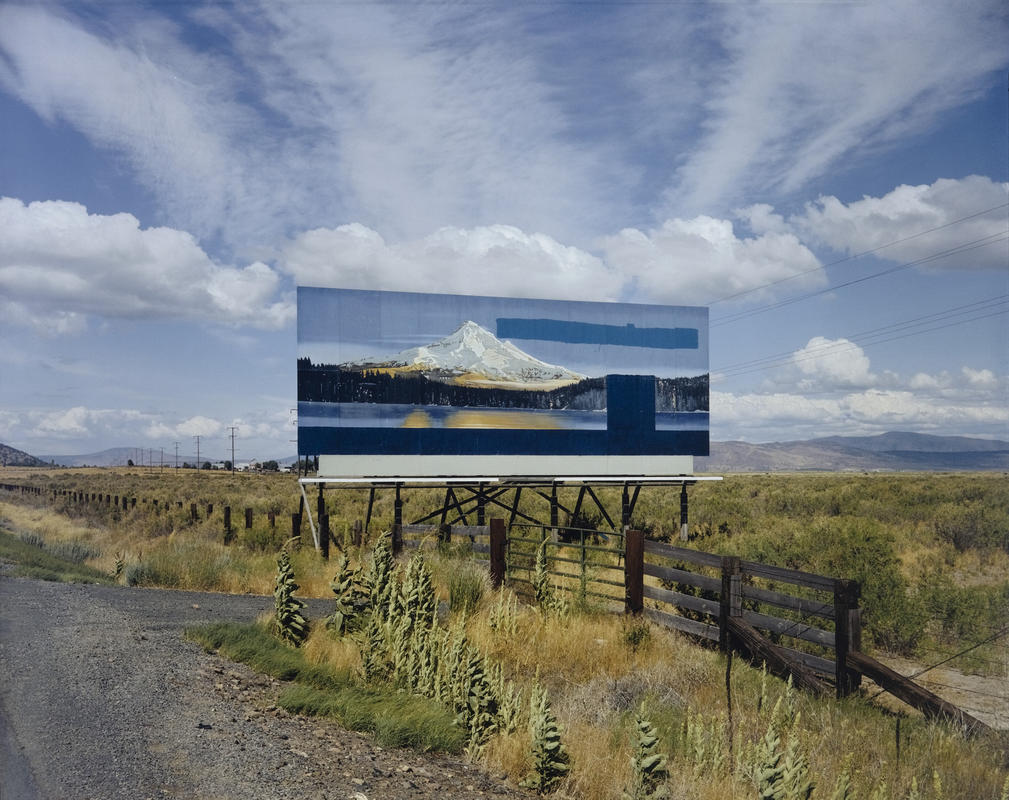More about U.S. 97, South of Klamath Falls, Oregon, July 21, 1973

Adjunct Instructor, Forsyth Technical Community College
What we have here is Stephen Shore’s landscape-ception.
Ah, yes, a painted billboard blocking a beautiful, natural mountain landscape. U.S. 97, South of Klamath Falls, Oregon, July 21, 1973 by Stephen Shore looks like a landscape you could pass on a roadtrip almost anywhere in the United States. At its center, we see a carefully crafted, picturesque billboard with a landscape of a mountain. Shore expertly captures a cool color palette, with a connection between the blues of the skies and water, greens of the foliage, and yellows of reflecting sun. The true subject of this image is not just the billboard but the play between the fake and the real, the image of the landscape on the billboard juxtaposed with the traditional landscape of the background. This photograph is the epitome of Shore’s work, with its exceptional use of color, quiet humor, and ordinary landscape turned fine art.
As a member of the New Topographics artist group, Shore created work about the transforming landscape of America, from the idyllic landscapes of National Parks or Romantic painted landscapes, to the more industrial and commercialized environment. The New Topographics photographers usually captured these ideas through a formal lens, putting the subjects in the center of the frame with strictly organized perspectives. During the 1970s, the public began to be concerned that the natural environment was being consumed for profits. One big sticking point was the abundance of unchecked billboards gunking up the authentic landscape, which ended up leading to vandalism, protests, and even legislation banning billboards in states like Maine and Vermont. In Klamath Falls, the picturesque billboard could very well be blocking the exact landscape that has been recreated. Within the context of this movement, Shore is able to capture images which poke fun at American society but also leave more questions than tell stories or answers.
The juxtaposition of the artificial and natural is the epitome of American vernacular. It plays into the core of the film "The Matrix" - okay, I know this is a jump, but hear me out! The film is based on French philosopher Jean Baudrillard’s theories of the simulation and simulacra. Baudrillard argues that postmodern society’s use of semiotics, where we rely on signs and symbols for interpretation, has evolved to the point where we do not consider what the symbols are based on; the simulation references the real, but the simulacra bases our reality on these nonexistent symbols or images, as in the simulacra. Shore, as well as "The Matrix," play on humanity’s ability to create an idealized, artificial version of the actual experience. While this work specifically plays on these ideas, Shore is able to capture these small moments others may overlook or not think twice about and put them in an ironic and even philosophical perspective. A master of color and form, Shore pulls irony, humor, and beautiful colors from the American landscape.
Sources
- "U.S. 97, South of Klamath Falls, Oregon." Metropolitan Museum of Art. Accessed May 22, 2022. https://www.metmuseum.org/art/collection/search/284982
- Proulx, Annie. Wild Beauty. The New York Times Style Magazine. November 9, 2017. Accessed May 22, 2022. https://www.nytimes.com/2017/11/09/t-magazine/stephen-shore-photographs…











